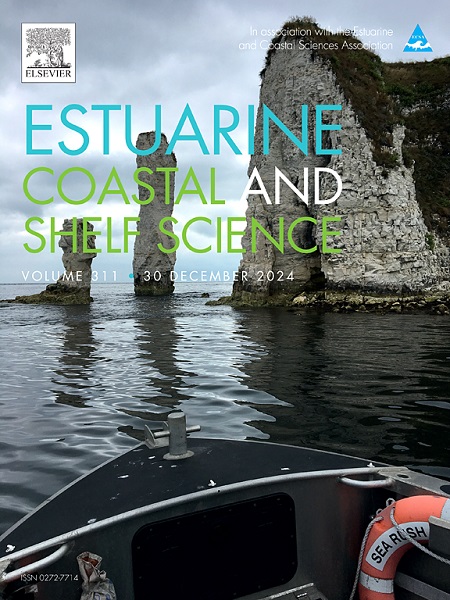Maritime and lagoon beaches sediments mineral phases and potentially toxic elements characterization and evaluation of microplastics retention
IF 2.6
3区 地球科学
Q1 MARINE & FRESHWATER BIOLOGY
引用次数: 0
Abstract
The present study aimed to characterize the texture, mineral phases, and geochemical composition of sixteen sediment samples of beaches in Portugal, from maritime and Ria de Aveiro lagoon environments. Additionally, the presence of Microplastics (MPs) in these sediments was estimated. Sediments from both environments were classified as sands, with a quartz content ranging ∼70–90 %. The physicochemical parameters showed neutral conditions, with pH between 6.16 and 7.05, typically of this type of setting. The concentration of As, Cr, and Zn was above sediment guidelines, suggesting anthropogenic contamination, particularly in one location, posing a risk to beach users. Contamination indices and toxicological assessment confirmed anthropogenic contamination, particularly by Cr on the maritime beaches, highlighting pollution and toxicity risk. This may be linked to industrial, domestic, and agricultural activities, population density, traffic, as well as traditional fishing practices. MPs were identified in both sediments and water samples from maritime and Ria de Aveiro beaches, ranging 38 to 958 MP/kg. The more abundant identified MPs were PUR, ABS, and PE, mainly in the form of fibers, with different colors.
海洋和泻湖海滩沉积物矿物相和潜在有毒元素的表征和评价微塑料滞留
本研究旨在表征葡萄牙海滩16个沉积物样品的质地、矿物相和地球化学组成,这些样品来自海洋和Ria de Aveiro泻湖环境。此外,还估计了这些沉积物中微塑料(MPs)的存在。两种环境下的沉积物均为砂,石英含量为~ 70 - 90%。理化参数为中性,pH值在6.16 ~ 7.05之间,属于典型的中性环境。砷、铬和锌的浓度高于沉积物标准,表明人为污染,特别是在一个地方,对海滩使用者构成了风险。污染指数和毒理学评估证实了人为污染,特别是海洋海滩上的Cr污染,突出了污染和毒性风险。这可能与工业、家庭和农业活动、人口密度、交通以及传统捕鱼方式有关。在海洋和Ria de Aveiro海滩的沉积物和水样中都发现了MPs,范围为38至958 MP/kg。发现的MPs数量较多的是PUR、ABS和PE,主要以纤维形式存在,颜色不同。
本文章由计算机程序翻译,如有差异,请以英文原文为准。
求助全文
约1分钟内获得全文
求助全文
来源期刊
CiteScore
5.60
自引率
7.10%
发文量
374
审稿时长
9 months
期刊介绍:
Estuarine, Coastal and Shelf Science is an international multidisciplinary journal devoted to the analysis of saline water phenomena ranging from the outer edge of the continental shelf to the upper limits of the tidal zone. The journal provides a unique forum, unifying the multidisciplinary approaches to the study of the oceanography of estuaries, coastal zones, and continental shelf seas. It features original research papers, review papers and short communications treating such disciplines as zoology, botany, geology, sedimentology, physical oceanography.

 求助内容:
求助内容: 应助结果提醒方式:
应助结果提醒方式:


